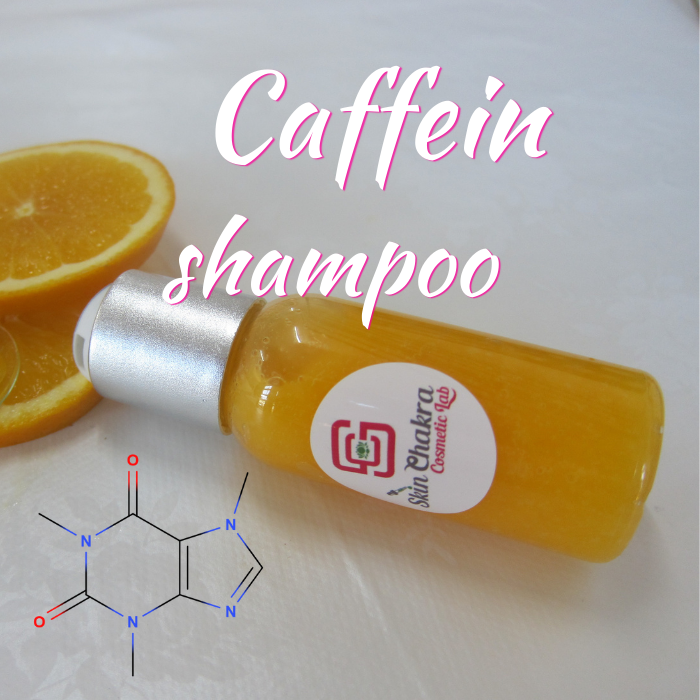
Caffein is a naturally occuring alkaloid and a known but underused cosmeceutical. Clinical studies dedicated to various caffein applications in dermatology are rather new but the promising prospects promote the interest in this field.
Cosmetic caffein is usuallyderived from tea or coffee and is a dry water soluble powder.
Caffein's impact on hair growth, hair follicle diameter and prevention of androgenic alopecia is among the most widely investigated properties of caffein. Caffein is rapidly absorbed by hair follicles within 20 minutes of application.
Caffein @ a dosage of 0,2% has proved to be as effective as a 5% minoxidal treatment. Apart from promoting hair growth and reduction of hair loss caffein reduces scalp itchiness, enhances hair shaft elongation and prolongs anagen-phase of the hair growth cycle.
Other dermatological applications of caffein are its application as a strong antioxidant, protecting the skin against UV radiation, improving the skin condition (to be exact exerting pro-apoptotic effects) in UV damaged unrepaired keratinocytes, reduction of TEWL, promoting wound healing and, you may not believe this one: improving the skin redness by rosacea. On top of all of the above, caffein has proved to be effective in improving the skin condition in psoriasis vulgaris and reducing the risks of bothe melanoma and non-melanoma skin cancer.
During the recent years caffein has been used in face care products to reduce under-eye puffiness as well as in body care (anti-cellulite) formulations. We have prepared several formulations with caffein in the past such as this hair and scalp toner or this cold process under eye serum but for this blog post we have prepared a beautiful caffein shampoo for you.
The formulation and procedure are rather straightforward. We are using Solagum AX as the gum/stabilizer and since it doesn't need any heat for full hydration we don't need to take care of the thermal stability of the ingredients.
We are using a preserved hydrosol with a low pH. If you work with distilled water or with a hydrosol with a higher pH you may have different results in pH adjustment. Since we are using a preservative system that works independent of pH we just blend all of the lipophilic ingredients in the surfactant phase and blend them all together before measuring the pH. If you are using a preservative system with a performance dependent on the pH you will have to take another approach and measure and adjust the pH before adding the preservative system.
All in one this is a really easy process.

You can watch the video here
Further reading and references:
Visconti, Michael J., Wasim Haidari, and Steven R. Feldman. "Therapeutic use of caffeine in dermatology: A literature review." Journal of Dermatology and Dermatologic Surgery 24.1 (2020): 18.
Li S, Chen ML, Drucker AM, Cho E, Geng H, Qureshi AA, et al. Association of caffeine intake and caffeinated coffee consumption with risk of incident rosacea in women. JAMA Dermatol 2018;154:1394-400.
Ferzli G, Patel M, Phrsai N, Brody N. Reduction of facial redness with resveratrol added to topical product containing green tea polyphenols and caffeine. J Drugs Dermatol 2013;12:770-4
Loftfield E, Freedman ND, Graubard BI, Hollenbeck AR, Shebl FM, Mayne ST, et al. Coffee drinking and cutaneous melanoma risk in the NIH-AARP diet and health study. J Natl Cancer Inst 2015;107. pii: dju421.
Fischer TW, Hipler UC, Elsner P. Effect of caffeine and testosterone on the proliferation of human hair follicles in vitro. Int J Dermatol 2007;46:27-35
Otberg N, Teichmann A, Rasuljev U, Sinkgraven R, Sterry W, Lademann J. Follicular penetration of topically applied caffeine via a shampoo formulation. Skin Pharmacol Physiol 2007;20:195-8.
Dhurat R, Chitallia J, May TW, Jayaraaman AM, Madhukara J, Anandan S, et al. An open-label randomized multicenter study assessing the noninferiority of a caffeine-based topical liquid 0.2% versus minoxidil 5% solution in male androgenetic alopecia. Skin Pharmacol Physiol 2017;30:298-305.


